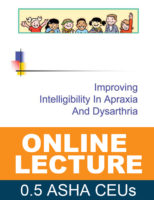Q: I have a student with a lateral lisp whose does not have proper jaw alignment. The jaw at rest and during speech is moved over to the right. My thoughts are that the misalignment of the jaw is causing lateralization of the sibilants. Is this correct? What are your thoughts? You are right. The jaw has to be in a stable midline position to produce a correct midline sibilant. I divide lateral lisps into several categories according to whether…
Jaw Position and Lateral Lisp
By Pam Marshalla

